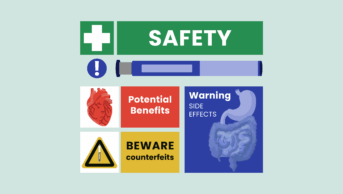There has been a growing consensus that the safest approach to discontinuing psychiatric medicines is through a gradual and hyperbolic tapering process. This concept is thoroughly explained in the informative article authored by Mark Horowitz and David Taylor entitled ‘Case-based learning: safe withdrawal and tapering of antidepressants‘, published by The Pharmaceutical Journal on 19 September 2023. Using three cases as examples, they illustrate how medical professionals, including pharmacists, can assist patients in tapering safely using currently available tools and equipment.
Patients may be instructed to perform various tasks, such as reading tables, splitting tablets, combining tablets, crushing tablets, weighing tablets, preparing suspensions, measuring with a syringe, opening capsules, counting beads, weighing beads, diluting, shaking vigorously, making fresh solutions and discarding unused portions daily. The specific tasks vary depending on the drug and the availability of lower-than-standard dosages or liquid formulations.
As of yet, there is no substantial data to inform us of the effectiveness of these methods; however, it appears highly unlikely that patients will be able to execute all these tasks without committing errors. This raises the question: is it fair to expect patients to carry out such complex procedures, or should we rely on pharmacists, GPs, psychiatrists and psychiatric nurses to provide the necessary guidance to prevent patient errors? This is especially concerning since medical professionals may not have sufficient time to provide this level of instruction, even when they desire to follow Horowitz and Taylor’s advice.
This situation also prompts an ethical question: is it fair to burden patients with responsibilities typically handled by trained and certified professionals, such as pharmacists who have the expertise and equipment to adjust dosages when necessary? Are there better and more patient-friendly options for medical professionals to assist patients in tapering safely?
In the Netherlands, a project was initiated in 2012, inspired by an idea published in a Dutch newspaper in 2004, which aimed to address these challenges based on personal experiences. After finding a cooperative pharmacist, the first so-called ‘tapering strips’ were developed, and continuous improvements followed with input from prescribing doctors and patients[1,2]. These enhancements enable doctors and patients to implement personalised, hyperbolic tapering schedules with ease — it is as simple as specifying the starting and ending doses and the desired duration.
Once the prescription is filled, the pharmacy promptly delivers the medication for the selected hyperbolic taper to the patient. Each day’s medication is individually packaged, eliminating the need for patients to break, crush, dilute tablets, open capsules, count beads, measure different liquid quantities or weigh medications repeatedly. This significantly reduces the risk of errors associated with these tasks.
For medical professionals, instructing and guiding patients becomes much more straightforward. Explaining the importance of gradual tapering becomes simpler, as complex terms like ‘hyperbolic,’ ‘receptor,’ ‘transporter,’ ‘occupancy,’ and ‘the law of mass action’, which some patients may find abstract and overwhelming, can be avoided when discussing why personalised gradual hyperbolic tapering is crucial. For most patients, a brief and straightforward explanation may suffice:
Reducing your dosage in numerous smaller steps, with each step becoming progressively smaller as your dose decreases, gives your body time to adapt to the slightly lower dose after each step. When you have sufficient time, withdrawal symptoms tend to occur much more slowly and less severely, or they may not occur at all. If withdrawal symptoms do arise, the gradual tapering of your medication provides you and your doctor with opportunities for timely intervention. For example, you can stabilise your dosage and then proceed more gradually. This can conveniently be achieved by using a stabilisation strip followed by a more gradual tapering strip. As a possible outcome of your tapering process, you may receive advice to continue your medication, potentially at a reduced dosage. Your gradual tapering approach offers a safer and more effective means of determining this.
In the Netherlands, thousands of patients have been prescribed tapering strips, allowing for an investigation of their effectiveness in daily clinical practice. Four observational studies have been conducted thus far, involving over 2,700 participants[3–6]. Approximately 60% of them had previously attempted to discontinue antidepressants, often experiencing severe withdrawal symptoms. These patients were able to compare their earlier experiences with their new tapering attempts using tapering strips. In the studies conducted so far, 70% of participants were successful in tapering, likely owing to experiencing fewer or no withdrawal symptoms. Results from the latest study suggest that this percentage may increase with more time for an even more gradual tapering process[5].
Horowitz and Taylor note that options for gradual tapering, such as the use of liquid medication, are not always available or, when they are, are sometimes considered too expensive. Given all the complexities surrounding the practical implementation of responsible and personalised tapers, the question arises as to whether the currently available tapering medication developed in the Netherlands could possibly provide a cost-effective and effective solution within the NHS.
Peter Groot, researcher at the UMC Utrecht Brain Centre, University Medical Centre Utrecht, the Netherlands
Jim van Os, psychiatrist and professor of epidemiological psychiatry at the UMC Utrecht Brain Centre, University Medical Centre Utrecht, the Netherlands
- 1Groot PC. Tapering strips for paroxetine and venlafaxine. Tijdschrift voor Psychiatrie. 2013.https://www.taperingstrip.nl/wp-content/uploads/docs/Groot_2013_Taperingstrips_paroxetine_venlafaxine.pdf (accessed Oct 2023).
- 2Groot PC, van Os J. How user knowledge of psychotropic drug withdrawal resulted in the development of person-specific tapering medication. Therapeutic Advances in Psychopharmacology. 2020;10:204512532093245. doi:10.1177/2045125320932452
- 3Groot PC, van Os J. Antidepressant tapering strips to help people come off medication more safely. Psychosis. 2018;10:142–5. doi:10.1080/17522439.2018.1469163
- 4Groot PC, van Os J. Outcome of antidepressant drug discontinuation with taperingstrips after 1–5 years. Therapeutic Advances in Psychopharmacology. 2020;10:204512532095460. doi:10.1177/2045125320954609
- 5Groot PC, van Os J. Successful use of tapering strips for hyperbolic reduction of antidepressant dose: a cohort study. Therapeutic Advances in Psychopharmacology. 2021;11:204512532110393. doi:10.1177/20451253211039327
- 6van Os J, Groot PC. Outcomes of hyperbolic tapering of antidepressants. Therapeutic Advances in Psychopharmacology. 2023;13:204512532311715. doi:10.1177/20451253231171518


